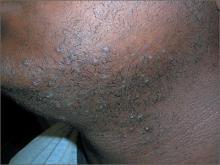The FP diagnosed pseudofolliculitis, a common skin condition affecting the hair-bearing areas of the body that are shaved. Potential complications include post-inflammatory hyperpigmentation, bacterial superinfection, and keloid formation.
Pseudofolliculitis is most common in black men and at least half of black men who shave are prone to it. The condition is called pseudofolliculitis barbae when it occurs in the beard area, and pseudofolliculitis pubis when it occurs after pubic hair is shaved. It may also occur in the neck area.
Pseudofolliculitis develops when, after shaving, the free end of a tightly coiled hair reenters the skin, causing a foreign-body-like inflammatory reaction. Tightly curled hair has a greater tendency to pierce the follicle and the surface of the skin, explaining the relative predominance of this condition in patients of African descent.
The FP encouraged the patient to avoid shaving as much as possible and to consider trying scissors or an electric clipper instead of a razor blade. The FP told the patient to search for ingrown hairs daily by using a magnifying mirror and to release them gently with a sterilized needle or tweezers.
The FP prescribed tretinoin cream 0.025% to be applied at night before sleep. While this medication is typically prescribed for acne, it can also help pseudofolliculitis. The FP also recommended trying over-the-counter hydrocortisone cream 1% for areas that were inflamed, painful, or itchy.
Alternative treatments involve chemical depilatories (such as Ali, Royal Crown, or Magic Shave), which cause fewer symptoms than shaving. However, these creams can cause severe irritation, so testing a small amount on the forearm is important. They work by breaking the disulfide bonds in hair, which results in the hair being bluntly broken at the follicular opening instead of sharply cut below the surface. They should be used every second or third day to avoid skin irritation, although this can be controlled with hydrocortisone cream.
Barium sulfide 2% powder depilatories can be made into a paste with water, applied to the beard, and removed after 3 to 5 minutes. Calcium thioglycolate preparations are left on for 10 to 15 minutes, but the fragrances can cause an allergic reaction and the treatment can result in chemical burns if left on for too long.
During a follow-up visit 2 months later, the skin on the young man’s face had improved and he was very pleased with the outcome. The FP recommended continuing the current regimen.
Photos and text for Photo Rounds Friday courtesy of Richard P. Usatine, MD. This case was adapted from: Mayeaux, EJ. Pseudofolliculitis and acne keloidalis nuchae. In: Usatine R, Smith M, Mayeaux EJ, et al, eds. Color Atlas of Family Medicine. 2nd ed. New York, NY: McGraw-Hill; 2013:665-670.
To learn more about the Color Atlas of Family Medicine, see: www.amazon.com/Color-Family-Medicine-Richard-Usatine/dp/0071769641/
You can now get the second edition of the Color Atlas of Family Medicine as an app by clicking on this link: usatinemedia.com


